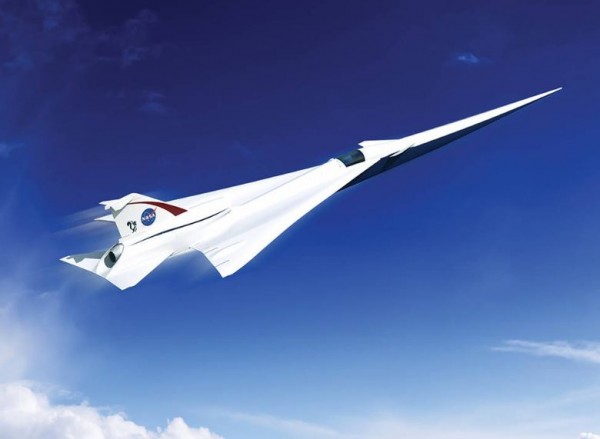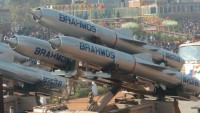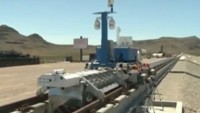Supersonic Jetliners are making a Comeback; will have Quieter Sonic Booms
| Arthur Dominic Villasanta | | Jun 21, 2016 05:11 AM EDT |
(Photo : NASA) NASA's QueSST X-plane in flight
The nostalgia for supersonic jetliners like the iconic BAC Concorde remains strong and new technologies are pushing startups and investors to build the next generation SSTs or supersonic transports that will again fly passengers faster than the speed of sound.
Concorde last flew in 2003 and in its 27 years of service set transatlantic flight speed records that still stand. The legendary jetliner was laid low by a combination of factors, including expensive air fares and a downturn in the aviation industry following the terrorist attacks of September 11, 2001 in the United States where aircraft were turned into flying bombs by Muslim terrorists from Saudi Arabia.
Like Us on Facebook
NASA and aerospace giant Lockheed Martin recently announced a new solution to muffling the irritating sonic boom problem that plagued Concorde and people on the ground.
Their solution has the acronym "QueSST" for Quiet Supersonic Technology. The demonstrator aircraft that will set out to prove this technology is an experimental X-plane designed to reach Mach 1.42 (1,800km/h) that will also limit the loudness of its sonic boom.
NASA later plans to use the technology being developed by Lockheed Martin in the QueSST program in business jets and on 100- to 120-seat airliners.
"We feel we have got the sonic boom now to the stage where it is not going to be bothersome to the general public," said Dave Richwine, NASA's Commercial Supersonic Technologies project manager.
To reduce the sound of sonic booms, aerospace engineers have to find a way to prevent pressure waves from combining into a single, huge shockwave, also called an N-wave. To prevent these N-waves, Lockheed engineers are working on a single-engine aircraft design that will prevent pressure waves on different parts of the aircraft from combining into one large shockwave.
This new design features a number of lifting surfaces that will keep shock waves separated. These lifting surfaces will include a small T-tail on a vertical fin; canards ahead of the wings and conventional horizontal tail wings. Those are all in addition to the main wings of the aircraft.
The result of these design changes will be the creation of an "S-wave," which is a series of small sonic booms that sound more like a rumble than the startling explosion associated with sonic booms. NASA hopes to ultimately develop a plane that makes less than 75 perceived noise level decibels (PNLdB), which is about 20 times quieter than the 105 PNLdB boom of the Concorde.
An American startup named Boom last March signed a deal with Virgin Galactic to build a supersonic jetliner that will attain its aim of making supersonic travel truly affordable in the era of budget airlines.
Based in Colorado, Boom plans to build a prototype SST that can fly at Mach 2.2 (2,700 km/h) by the end of 2017. Boom said it will use existing engines and composite materials to build its jetliners that can each carry some 40 passengers.
Boom plans to price its transatlantic roundtrips at around $5,000, about the price of ordinary business class. A supersonic flight from New York to London in a Boom SST should take only 3.5 hours. This trip takes close to seven hours on an ordinary passenger jet.
Virgin Galactic, which was founded by Sir Richard Branson, said it's signed an option to buy 10 SSTs from Boom for $2 billion if everything goes according to plan. Virgin Galactic's spacecraft maker, The Spaceship Company, will assist with the design and development of the prototype jetliner.
"We're not using any technology that doesn't already exist. It's just putting it together in the right way. This is supersonic passenger air travel. No bullshit and it's actually affordable," said Boom founder and CEO Blake Scholl.
TagsConcorde, NASA, Lockheed Martin, QueSST, Quiet Supersonic Technology, Boom, Sir Richard Branson
©2015 Chinatopix All rights reserved. Do not reproduce without permission
EDITOR'S PICKS
-

Did the Trump administration just announce plans for a trade war with ‘hostile’ China and Russia?
-

US Senate passes Taiwan travel bill slammed by China
-

As Yan Sihong’s family grieves, here are other Chinese students who went missing abroad. Some have never been found
-

Beijing blasts Western critics who ‘smear China’ with the term sharp power
-

China Envoy Seeks to Defuse Tensions With U.S. as a Trade War Brews
-

Singapore's Deputy PM Provides Bitcoin Vote of Confidence Amid China's Blanket Bans
-

China warns investors over risks in overseas virtual currency trading
-

Chinese government most trustworthy: survey
-

Kashima Antlers On Course For Back-To-Back Titles
MOST POPULAR
LATEST NEWS
Zhou Yongkang: China's Former Security Chief Sentenced to Life in Prison

China's former Chief of the Ministry of Public Security, Zhou Yongkang, has been given a life sentence after he was found guilty of abusing his office, bribery and deliberately ... Full Article
TRENDING STORY

China Pork Prices Expected to Stabilize As The Supplies Recover

Elephone P9000 Smartphone is now on Sale on Amazon India

There's a Big Chance Cliffhangers Won't Still Be Resolved When Grey's Anatomy Season 13 Returns

Supreme Court Ruled on Samsung vs Apple Dispute for Patent Infringement

Microsoft Surface Pro 5 Rumors and Release Date: What is the Latest?












